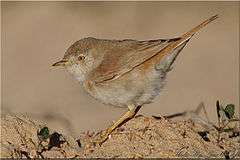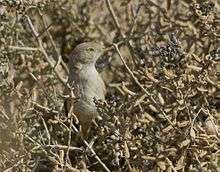Asian desert warbler
| Asian desert warbler | |
|---|---|
 | |
| Scientific classification | |
| Kingdom: | Animalia |
| Phylum: | Chordata |
| Class: | Aves |
| Order: | Passeriformes |
| Family: | Sylviidae |
| Genus: | Sylvia |
| Species: | S. nana |
| Binomial name | |
| Sylvia nana (Hemprich & Ehrenberg, 1833, southern El Tor, Sinai Peninsula) | |
| Synonyms | |
|
Sylvia nana theresae | |

The Asian desert warbler (Sylvia nana) is a typical warbler which breeds in the deserts of central and western Asia and the extreme east of Europe (Volga Delta area east to western Inner Mongolia in China), and migrating to similar habitats in southwestern Asia (Arabia to northwestern India) and the far northeast of Africa (Red Sea coastal regions) in winter. Until recently it was considered conspecific with the African desert warbler (and called just "desert warbler"),[2] but is now given specific status.[3][4] The two are still each other's closest living relatives, and their relationships to other typical warblers are not clear. They may be fairly close to the whitethroat; particularly, female whitethroats look much like a richly-coloured Asian desert warbler. But it seems that all these three taxa are fairly basal members of the genus.[5][6]
It is a small bird (the second-smallest in the genus after African desert warbler), 11.5–12.5 cm long. The sexes are almost identical in colour, pale grey-brown above with browner wings and tail, and whitish below; the bill and legs are yellowish, and the eye has a yellow iris. Like its relatives, it is insectivorous, but will also take small berries; unlike most warblers, it commonly feeds on the ground. The song is a distinctive jingle often given in an advertisement flight, with a mix of clear and harsher notes. It breeds in semi-desert and dry steppe environments, as long as some bushes for nesting occur. The nest is built in low shrub, and 4–6 eggs are laid.[2][4]
It has occurred as a rare vagrant as far west as Great Britain.[7]
The genus name is from Modern Latin silvia, a woodland sprite, related to silva, a wood. The specific nana is Latin for "dwarf", from earlier Ancient Greek nanos.[8]
References
- ↑ BirdLife International (2012). "Sylvia nana". IUCN Red List of Threatened Species. Version 2013.2. International Union for Conservation of Nature. Retrieved 26 November 2013.
- 1 2 Del Hoyo, J., Elliot, A., & Christie, D. (editors). (2006). Handbook of the Birds of the World. Volume 11: Old World Flycatchers to Old World Warblers. Lynx Edicions. ISBN 84-96553-06-X.
- ↑ IOC World Bird List version 2.9: Old World Warblers
- 1 2 Svensson, L., Mullarney, K. & Zetterström, D. (2009). Collins Bird Guide, second edition. HarperCollins, London ISBN 978-0-00-726726-2.
- ↑ Helbig, A. J. (2001). The characteristics of the genus: Phylogeny and biogeography of the genus Sylvia. Pages 24–28 in: Shirihai, H., Gargallo, G., Helbig, A. J., & Harris, A. Sylvia Warblers. Helm Identification Guides ISBN 0-7136-3984-9
- ↑ Jønsson, K. A., & Fjeldså, J. (2006). A phylogenetic supertree of oscine passerine birds (Aves: Passeri). Zool. Scripta 35 (2): 149–186. doi:10.1111/j.1463-6409.2006.00221.x (HTML abstract).
- ↑ Dymond, J. N., Fraser, P. A., & Gantlett, S. J. M. (1989). Rare Birds in Britain and Ireland. T & A D Poyser ISBN 0-85661-053-4.
- ↑ Jobling, James A (2010). The Helm Dictionary of Scientific Bird Names. London: Christopher Helm. pp. 265, 376. ISBN 978-1-4081-2501-4.
